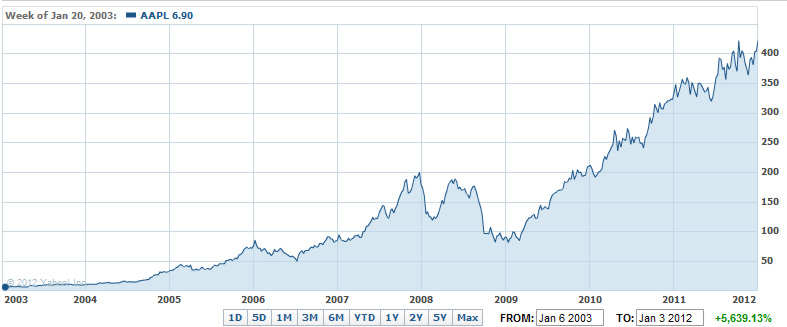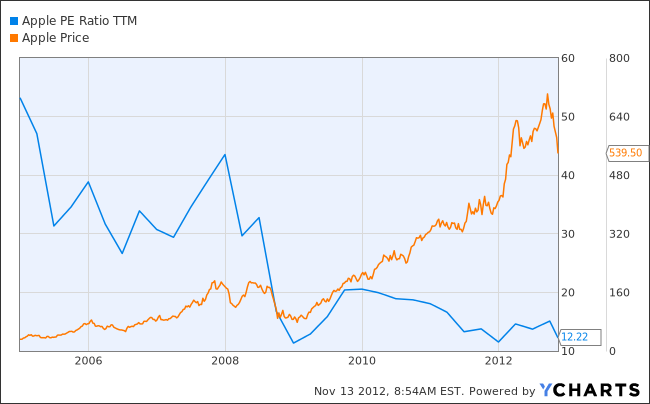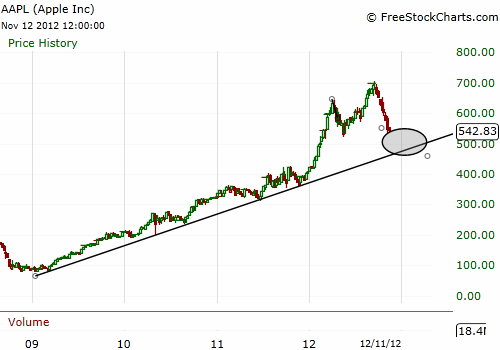Street Calls of the Week
These 3 investor emotions are powerful: fear, greed and logic. Logic is the predominant emotion when paper-trading or otherwise used when no money is at stake. It is why many people can profitably paper-trade but lose when using real capital. The moment you invest, fear and greed often overwhelm your power of reason.
Consider how this works in the case of Apple (AAPL). As prices were nearing their peak this year you could nary say a negative word about Apple shares without being swarmed by perma-bulls hurling insults calling you stupid and pointing to past results. The price spike from less than $400 to over $600 during the first few months of 2012 was jaw-dropping.
Much of this price increase may have been from envious traders looking from the sidelines at the beginning of 2012 who missed out on the almost 400% price increase since 2009 or 5,600% price increase since 2003 (see chart below).

But risk aversion may have also played a role. Between 2003 and 2012, shares of Apple made a fairly steady increase. If you are a risk averse investor, when do you typically buy a stock? – when it is moving up and down like a teeter-totter or when price seems to have stabilized over many years with consistent annual price increases?
Interestingly, our aversion to risk would have us buying after a long price increase which also happens to be at the very time when a correction is more likely. And when prices drop by 20% or more we are nervous to buy for fear prices could go lower… which often happens to be the best time to accumulate provided fundamentals are in-tact. Envy has us buying after long price increases and fear has us selling after prices crash. Buy high and sell low?
So how can we increase the power of logic while at the same time decreasing the influence of fear and envy? The key is to limit your exposure to sources which pump prices in shares they own or incite a panic-drop to profit from a short position. In simple language – ignore the herd which includes Wall Street. Following price action is okay, but don’t get caught up in looking out the rear-view mirror and waiting for months or years of a price trend before buying. You’ll likely do better by watching price as it relates to fundamentals.
In line with this, you should have a rules-based trading system to take as much emotion out of the equation as possible. Don’t have a touchy-feely system where you look at hundreds of ratios and read everything written on the net to get a "gut feeling." The most negative information is written when you should be buying and the most bullish outlook is often at the price peak. Keep it simple and follow it religiously.
Reason to Buy #1: P/E Ratio Averages
Historically, the two best times to buy Apple for quick gain in recent years was when the price to earnings ratio fell to 11.3 – 11.5. The earnings valuation fell this low in 2009 and was at this point once again at the beginning of 2012.

True, Apple is maturing, now offers a dividend and earnings growth is slowing which may mean the 20 – 30 PE range is a thing of the past. Looking at absolute valuation, the current PE ratio of just over 12 is attractive for a dividend stock – especially one that is a leading brand with a large following and decent future growth prospects. Even if earnings growth flat-lines, an earnings yield of over 8% is decent.
If the PE ratio were to fall 11.5, this would give us an a solid entry price of $507.72.
Reason to Buy #2: Attractive Trendline Setup
I didn’t find complex technical analysis that useful as a trader. The hardest challenge was to make logic overwhelm fear, envy and frustration…its harder than you think. The tools that I used were simple: a couple moving averages for possible stall or bounce zones, basic trend lines, and the S&P 500 futures. Some of my most profitable and consistent trades were using the breakdown of a trend line. You can read about my market analysis from a trading perspective here which includes broken trend lines and simple moving average pullbacks.
Another common use of the trend line is a long-term trend line bounce, which seems more well-suited for Apple due to the compacting fundamentals with good value. Does anyone really expect this stock to fall down to $260 with a PE ratio of 6? I hardly think so. Thus, even if the trend line should break I would discourage shorting.
Using weekly bars to show a long-term chart, Apple is entering the zone where I would recommend systematic buying over the next 6 months.

Say you want to get into Apple with $60K, buy $10K worth per month between now and May. You very well might see a drawdown of over 10% but it’s a far better strategy than waiting for prices to spike for months on end before legging in.
This ties in well with another simple strategy, which is actually a third reason, where I have a list of my best stocks and put them on my short-list for fundamental and valuation testing following a pullback of 20% or more. Since mid-September, Apple has pulled back almost 25%. While earnings growth has slowed down, it still has fair value even if the long-term growth rate fell by almost half.
Bottom Line
I find Apple valuations and future projections to be attractive. At the same time, investors should be realistic in their expectations and not hope for a double-bagger over the next year. If you start accumulating now and leave enough ammo to buy at monthly intervals over the next 6 months you will likely do well in a 5 to 10 year time frame.
Even if margins and earnings growth continue to slow, there is enough value at these levels that you could easily imagine a 50% total return in 5 years. If the compound annual growth rate of earnings slowed to 12% over the next 10 years, and the PE ratio stayed at 12, shares would be at $930 in 5 years and $1,640 in 10 years. That seems like a decent return for a low projection and the upside potential could be much higher.
Consider how this works in the case of Apple (AAPL). As prices were nearing their peak this year you could nary say a negative word about Apple shares without being swarmed by perma-bulls hurling insults calling you stupid and pointing to past results. The price spike from less than $400 to over $600 during the first few months of 2012 was jaw-dropping.
Much of this price increase may have been from envious traders looking from the sidelines at the beginning of 2012 who missed out on the almost 400% price increase since 2009 or 5,600% price increase since 2003 (see chart below).

But risk aversion may have also played a role. Between 2003 and 2012, shares of Apple made a fairly steady increase. If you are a risk averse investor, when do you typically buy a stock? – when it is moving up and down like a teeter-totter or when price seems to have stabilized over many years with consistent annual price increases?
Interestingly, our aversion to risk would have us buying after a long price increase which also happens to be at the very time when a correction is more likely. And when prices drop by 20% or more we are nervous to buy for fear prices could go lower… which often happens to be the best time to accumulate provided fundamentals are in-tact. Envy has us buying after long price increases and fear has us selling after prices crash. Buy high and sell low?
3rd party Ad. Not an offer or recommendation by Investing.com. See disclosure here or remove ads.
So how can we increase the power of logic while at the same time decreasing the influence of fear and envy? The key is to limit your exposure to sources which pump prices in shares they own or incite a panic-drop to profit from a short position. In simple language – ignore the herd which includes Wall Street. Following price action is okay, but don’t get caught up in looking out the rear-view mirror and waiting for months or years of a price trend before buying. You’ll likely do better by watching price as it relates to fundamentals.
In line with this, you should have a rules-based trading system to take as much emotion out of the equation as possible. Don’t have a touchy-feely system where you look at hundreds of ratios and read everything written on the net to get a "gut feeling." The most negative information is written when you should be buying and the most bullish outlook is often at the price peak. Keep it simple and follow it religiously.
Reason to Buy #1: P/E Ratio Averages
Historically, the two best times to buy Apple for quick gain in recent years was when the price to earnings ratio fell to 11.3 – 11.5. The earnings valuation fell this low in 2009 and was at this point once again at the beginning of 2012.

True, Apple is maturing, now offers a dividend and earnings growth is slowing which may mean the 20 – 30 PE range is a thing of the past. Looking at absolute valuation, the current PE ratio of just over 12 is attractive for a dividend stock – especially one that is a leading brand with a large following and decent future growth prospects. Even if earnings growth flat-lines, an earnings yield of over 8% is decent.
3rd party Ad. Not an offer or recommendation by Investing.com. See disclosure here or remove ads.
If the PE ratio were to fall 11.5, this would give us an a solid entry price of $507.72.
Reason to Buy #2: Attractive Trendline Setup
I didn’t find complex technical analysis that useful as a trader. The hardest challenge was to make logic overwhelm fear, envy and frustration…its harder than you think. The tools that I used were simple: a couple moving averages for possible stall or bounce zones, basic trend lines, and the S&P 500 futures. Some of my most profitable and consistent trades were using the breakdown of a trend line. You can read about my market analysis from a trading perspective here which includes broken trend lines and simple moving average pullbacks.
Another common use of the trend line is a long-term trend line bounce, which seems more well-suited for Apple due to the compacting fundamentals with good value. Does anyone really expect this stock to fall down to $260 with a PE ratio of 6? I hardly think so. Thus, even if the trend line should break I would discourage shorting.
Using weekly bars to show a long-term chart, Apple is entering the zone where I would recommend systematic buying over the next 6 months.

Say you want to get into Apple with $60K, buy $10K worth per month between now and May. You very well might see a drawdown of over 10% but it’s a far better strategy than waiting for prices to spike for months on end before legging in.
3rd party Ad. Not an offer or recommendation by Investing.com. See disclosure here or remove ads.
This ties in well with another simple strategy, which is actually a third reason, where I have a list of my best stocks and put them on my short-list for fundamental and valuation testing following a pullback of 20% or more. Since mid-September, Apple has pulled back almost 25%. While earnings growth has slowed down, it still has fair value even if the long-term growth rate fell by almost half.
Bottom Line
I find Apple valuations and future projections to be attractive. At the same time, investors should be realistic in their expectations and not hope for a double-bagger over the next year. If you start accumulating now and leave enough ammo to buy at monthly intervals over the next 6 months you will likely do well in a 5 to 10 year time frame.
Even if margins and earnings growth continue to slow, there is enough value at these levels that you could easily imagine a 50% total return in 5 years. If the compound annual growth rate of earnings slowed to 12% over the next 10 years, and the PE ratio stayed at 12, shares would be at $930 in 5 years and $1,640 in 10 years. That seems like a decent return for a low projection and the upside potential could be much higher.
Which stock should you buy in your very next trade?
With valuations skyrocketing in 2024, many investors are uneasy putting more money into stocks. Unsure where to invest next? Get access to our proven portfolios and discover high-potential opportunities.
In 2024 alone, ProPicks AI identified 2 stocks that surged over 150%, 4 additional stocks that leaped over 30%, and 3 more that climbed over 25%. That's an impressive track record.
With portfolios tailored for Dow stocks, S&P stocks, Tech stocks, and Mid Cap stocks, you can explore various wealth-building strategies.
